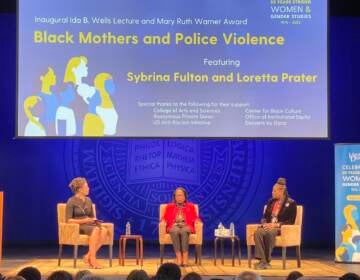How reporting while Black during a summer of uprisings changed us
An episode of Real Black History provides a behind-the-scenes look at what it’s like for Black reporters covering issues that affect our own communities.
Listen 25:10
Black Lives Matter protesters led by Romel Clark (center) march through Fishtown on June 2, 2020. (Layla A. Jones/WHYY)
I’ve been replaying a memory from last summer for months. It’s May 31, 2020, and I’m standing in the ShopRite on 52nd and Parkside, about a mile from my Mill Creek apartment building. I’m there buying red velvet cake for my roommate Shay. It’s her birthday weekend, and red velvet cake is her favorite.
I’m standing at the self-checkout holding my red cake with my feet planted on the white tile floor that’s now red with wine.
People who look like me are walking fast and running, carrying grocery items. I remember seeing a man holding a few different things I can’t make out in my mind anymore, but one of those things is a pack of diapers. And I hear a woman’s voice saying something like:
“Why are ya’ll doing this?!”
Then, I hear a young man’s voice say back:
“You need to be doing it, too!”
To which she responds:
“No! I’m not broke. I’m gonna pay for my groceries!”
I scan my little cake. Maybe it was about $2.99. I probably don’t bag it. I walk to my car, click on my seatbelt. I drive home down Belmont Avenue and see people pushing some heavy looking equipment, obviously from the nearby Lowe’s, haphazardly down the street.
I wonder, “Is this ‘looting?”
Six days before, police in Minneapolis had killed George Floyd. One day before this memory, protests had begun in Philadelphia.
Reporters of all races and ethnicities deployed to cover the unrest. As a Billy Penn reporter, I was one of those, along with my WHYY colleagues Darryl C. Murphy and Taylor Allen. We’re from different parts of the country and we were strangers before meeting at work. Our binding commonality? We are Black people.
We live in the neighborhoods most affected when there’s police misconduct and subsequent demonstrations. As Black people, we are personally affected, too.
This Real Black History episode is a behind-the-scenes look at what it’s like for us to cover the issues that we also are living with in our communities.
Police violence and the killings of Black Americans, documented on smartphones and virally shared on social media, catalyzed last summer the most intense public display of American resistance seen in a generation.
When the now-convicted murderer and former-cop Derek Chauvin publicly executed a father, former college athlete, and Christian mentor named George Floyd as Floyd lay immobile and handcuffed on the ground, a massive landmine loaded with systemic racism, institutional oppression, generational inequity, willful disinvestment, and deep-seated pain exploded, reverberating across the nation and around the world.
Philadelphia experienced some of the world’s loudest booms.
The result was unrelenting protest in all forms — peaceful, political, anarchic, violent. There was marching and chanting, seated civil disobedience, fires set in rage, flames extinguished in love, windows shattered, communities rebuilt, businesses broken into and robberies that were rooted in economic oppression, and yes, out of opportunism, in some instances.
Protest was met with resistance, especially from police, who, in Philly, became international examples of how not to handle your own citizens.
Black reporters walked — and sometimes ran — on the frontlines last summer to cover the turmoil that also invoked for us feelings of trauma, sadness, rage… and determination.
Police tear-gassed my colleague Taylor while she reported on protests in Colorado. When she returned to Philly to work at WHYY, she was tasked again with covering unrest as police and protesters clashed in our streets. On this day, she was ready to cover reaction after the Derek Chauvin verdict. If he was acquitted, would there be an uncontrolled eruption after the collective trauma the nation suffered from seeing Floyd’s murder on video, on repeat? Anticipating tear gas or worse, she suppressed a panic attack to complete her assignment.
Darryl lives just blocks from 52nd Street, a busy Black neighborhood business corridor where protesters demonstrated over the course of two seasons. In the summer, after George Floyd was killed, and in the fall after Philly police killed Walter Wallace, Jr., in Cobbs Creek. There, police sprayed tear gas and shot rubber bullets at peaceful protesters and uninvolved residents and bystanders. Chain stores like Foot Locker and some small, local businesses were burglarized. A couple got engaged during the melee. Darryl could hear the chaos from his home, including helicopters circling above for hours.
I traveled again and again to Fishtown, a historically Irish Catholic neighborhood where a group of white residents told me they were alerted by the police that “looters were coming.” In response, some took up makeshift weapons like bats, roamed the streets, and physically attacked people they thought were there in support of Black Lives Matter. A few men told me they were protecting their neighborhood from looting. Anxious and alone, I went down to interview them. I was undeterred, with my mind planted firmly on trailblazers like Ida B. Wells, the early 20th century Black woman journalist who dedicated her life to truth-telling in the face of brutal racial violence.
Cliche as it may be, I believe I stand on her shoulders. And we stand on the shoulders of local Black reporters like Linn Washington, whom we interviewed for this episode and who has covered racism, police and law for nearly five decades in Philadelphia.
Like them, we’re here to continue the legacy of bearing witness and telling the true story of Real Black History.

Get daily updates from WHYY News!
WHYY is your source for fact-based, in-depth journalism and information. As a nonprofit organization, we rely on financial support from readers like you. Please give today.









